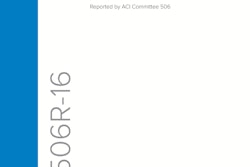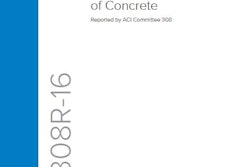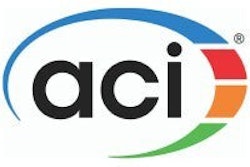The Concrete Research Council (CRC) has announced that it will provide research grants to four projects this year. The CRC is a council of the American Concrete Institute’s non-profit subsidiary, the ACI Foundation. The ACI Foundation’s steadfast commitment to progress, innovation, and collaboration within the concrete industry led to a 2015 decision to increase the level of funding from $10,000 per project to up to $50,000 per project with the intent for greater and more strategic impact on the concrete industry.
CRC’s annual call for proposals yielded an unprecedented high volume of research proposal submissions this past year. The quality of these submissions was outstanding and showed significant support from both ACI technical committees and industry, and also included cost sharing from universities at various levels. “The efforts of the CRC will boost the impact that the ACI Foundation’s funding will have on the concrete industry,” states Joe Bracci, CRC Chair. “The increase in grant amount and more competitive selection process has brought more proposals from researchers, and more interest and support from ACI Committees.” More information about this year’s awarded projects is below:
Update to Guidelines for Performance-Based Seismic Design of Tall Buildings
This project was created with the goal of advancing the seismic design of tall buildings. Performance-based design, review, acceptance, and construction of buildings using materials, structural systems and devices that may or may not be covered by the prescriptive provisions of today’s building codes are examined in in this research. The ultimate endgame of this undertaking is an update of the document Guidelines for Performance-Based Seismic Design of Tall Buildings.
The updated document will provide building owners and developers with the ability to create more efficient and functional buildings. Designers, reviewers, and building officials will have clearer design requirements allowing for a more streamlined design and review process. Finally, the updated guide will benefit the public by the creation of more buildings that renew urban centers and are more environmentally friendly.
Principal Investigators: Jack Moehle, University of California, Berkeley; Ron Hamburger, Simpson Gumpertz & Heger.
Major Funder: Charles Pankow Foundation.
Supporting ACI Committee: 318, Structural Concrete Building Code, Subcommittee H, Seismic Provisions.
Towards Mechanistic Pavement Design of Pervious Concrete Pavements
This research explores Pervious Concrete Pavement (PCP), a technology that is often a desirable pavement option for city streets, bike lanes, parking lots, and sidewalks due to its fast infiltration of storm water. PCP minimizes ponding, spraying, and hydroplaning. While PCP is gaining in popularity for low-volume applications, no fatigue model is currently calibrated for use in mechanical pavement design procedures. This project will perform field and laboratory testing on several PCP installments to study how CPC fatigues. Findings from this project will be integrated into pavement design procedures, specifically PerviousPave and will be coupled with future field performance in order to create a workable fatigue model for PCP.
Principal Investigators: Somayeh Nassiri, PhD, PEng, Assistant Professor, and J Daniel Dolan, PhD, PE, Professor, both at Washington State University.
Co-Funders: Washington State University, Boeing.
Supporting ACI Committee: 522, Pervious Concrete.
Industry Support: Washington State DOT.
Establishing Unified Durability Guidance on Chloride Ions Limits, Freeze-Thaw Performance, and External Sulfate Attack for ACI Documents
This project brings unified guidance on durability to concrete design and construction industry professionals by rectifying discrepancies between ACI documents that pertain to chloride limits, freeze-thaw attack, and sulfate attack. Specifically, this project would like to bring chloride limits in new concrete, strength requirements, and air content for avoiding freeze-thaw related damage, and strength requirements for avoiding sulfate attack all into agreement in order to provide the industry with unified guidance. The project would analyze existing data from concrete durability field exposure sites, laboratory testing and published literature to make recommendations.
Principal Investigator: Jason H. Ideker, Oregon State University; Kimberly E. Kurtis, Georgia Institute of Technology; Michael D. A. Thomas, University of New Brunswick; and Anthony F. Bentivegna, CTLGroup.
Supporting ACI Committees: 201, Durability of Concrete; 222, Corrosion of Metals in Concrete; 318, Structural Concrete Building Code; 350-B, Durability.
Industry Support: US Army Corps of Engineers.
Deformed Steel Fibers as Minimum Shear Reinforcement in Deep, Prestressed Concrete Hollow-Core Slabs
This research looks to evaluate the conditions under which steel fibers may be used as a minimum sheer reinforcement in precast, prestressed hollow-core concrete slabs. Precast, prestressed hollow core slabs are widely used in residential and industrial construction due to their light weight, low cost, and rapid field assemblage. Research has shown, however, that the web‐shear cracking strength of relatively deep hollow‐core‐slabs could be substantially lower than that calculated following the ACI Code provisions. The only feasible solution in past, when increased shear strength is required, has been to fill the cores with concrete. This solution adds both substantial slab weight and labor costs. A potentially more cost effective solution is to use deformed steel fibers to increase the sheer strength. The proposed research is aimed at generating necessary experimental data to evaluate the conditions under which steel fibers may be used as minimum shear reinforcement of in precast, prestressed hollow-core concrete slabs.
Principal Investigator: Gustavo J. Parra‐Montesinos, University of Wisconsin–Madison.
Co-Funders: In-kind support from Mid-States Concrete Industries and Spancrete.
Supporting ACI Committees: 318-Subcommittee G, Precast and Prestressed Concrete.
Industry Support: Mid-States Concrete Industries and Spancrete.
The CRC’s annual call for new proposals takes place in August and closes on the first of December. Selection of awarded projects and notifications to principal investigators occurs after the ACI Spring Concrete Convention and Exposition. For more information on the latest CRC-funded projects, research products, and the latest information on our upcoming request for proposals, please visit www.ConcreteResearchCouncil.org.


















